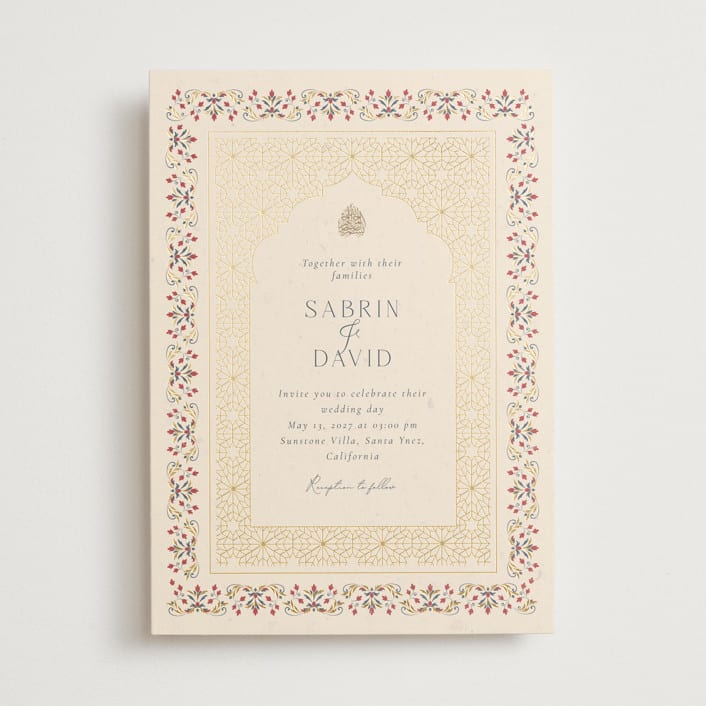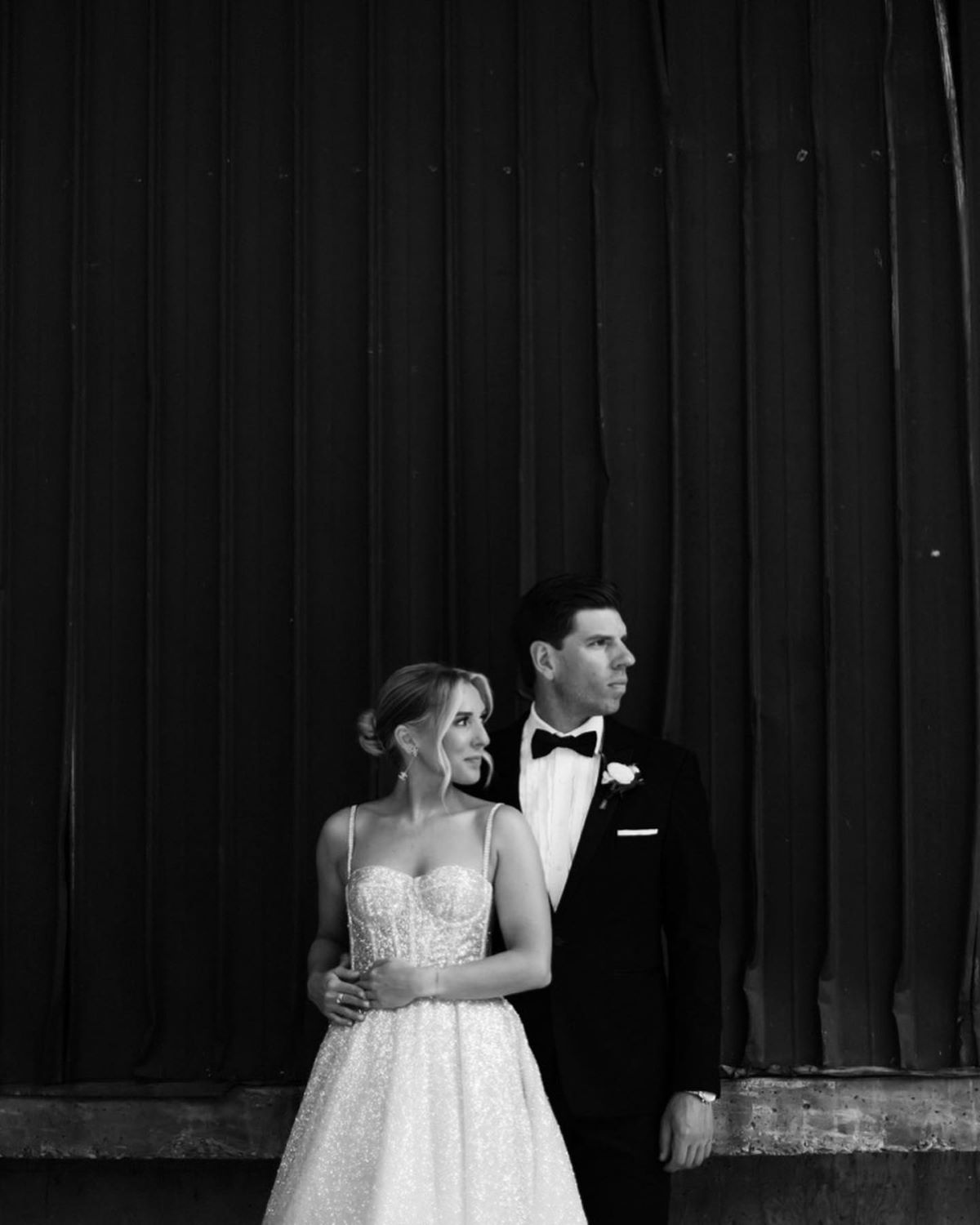For many couples, reciting traditional wedding vows that reflect their faiths is the most important part of the wedding ceremony. No matter what faith they practice, incorporating traditional vows and ceremonies that have been passed down over the course of generations is a beautiful way to engage in history and make their wedding even more deeply meaningful.
In this article, the wedding-planning experts at Minted have compiled wedding vows examples, ring exchange wording, and other traditions from a wide range of faiths for you to explore as you plan a wedding ceremony that is a true reflection of you and your partner.
Wedding Vows 101:
Who says wedding vows first? The bride or groom?
In a traditional wedding, the groom is usually the one to say his vows first. But today, either part of the couple has the option of saying their vows first. This preference on vows varies depending on what you select as a couple, your beliefs, what your officiant recommends, or the order of events you choose.
How long should it take to say traditional wedding vows?
Traditional wedding vows last between 30 seconds and three minutes on average. While this is ultimately your opportunity to express your sentiments to your future spouse, it's polite to keep track of the time. Your wedding planner can help you plan them properly so you can stick to your pre-planned timeline.
Can You Personalize Traditional Wedding Vows?
The level to which you can personalize your vows depends on which tradition you plan to follow for your wedding ceremony. For example, if your wedding is being held in a place of worship by and officiated by a minister of a more orthodox religion (such as Catholicism or Judaism) you may not be able to personalize traditional wedding vows at all. If you plan to get married in a church, synagogue, mosque, or temple, be sure to ask about officiating practices when touring the venue to get a sense of how much you’ll be able to put a personal spin on the ceremony if that is important to you.
How to write your own wedding vows
It can be a huge task to summarize your love, dreams, and commitments to your lover in just a few minutes. To learn how to write your wedding vows and dream up the perfect program for your big day, head on over to our very own wedding vows guide to get started.

Photo by Barbarah Perttula Photography
Traditional Christian Wedding Vows
Example Vows:
Traditional Christian wedding vows can vary by denomination, but all follow the same structure. Each partner will make a promise to God and to the other person that they will stay committed to them through life ups and downs. Below, we’ve provided a few of the most common traditional Christian Wedding vows.
Church of England Vows:
“I,________, take you, ________,
to be my wife/husband,
to have and to hold from this day forward;
for better, for worse,
for richer, for poorer,
in sickness and in health,
to love and to cherish,
till death us do part,
according to God's holy law.
In the presence of God, I make this vow.”
Baptist Vows:
Officiant: “Will you, ________, have ________ to be your husband/wife? Will you love him/her, comfort and keep him/her, and forsaking all others, remain true to him/her as long as you both shall live?"
Wedded couple (together or individually): “I will.”
Presbyterian Vows:
“I, ________, take thee ________, to be my wedded husband/wife, and I do promise and covenant, before God and these witnesses, to be thy loving and faithful wife/husband; in plenty and in want, in joy and in sorrow, in sickness and in health, as long as we both shall live.”
Methodist Vows (declaration of consent):
“I take you, ________, to be my husband/wife from this day forward, to join with you and share all that is to come, and I promise to be faithful to you of God and this congregation to declare your intent.”
Ring Exchange Wording
Like vows, Christian ring exchange wording can vary slightly depending on denomination. But, while the exact words spoken may be different, all Christian ring exchange ceremonies begin with the minister or officiant blessing he rings with a prayer.
Basic Ring Exchange Wording:
“________, I give you this ring as a symbol of our vows, and with all that I am, and all that I have, I honor you. In the name of the Father, and of the Son, and of the Holy Spirit. With this ring, I thee wed.”
Baptist Ring Exchange Wording:
“With this ring, I thee wed, and all my worldly goods I thee endow. In sickness and in health, in poverty or in wealth, 'til death do us part.”
Presbyterian Ring Exchange Wording:
“This ring I give you, in token and pledge of our constant faith and abiding love."
Other Traditions
Traditionally in Christian weddings, the bride wears a white dress and veil. The bride enters the church and walks down the aisle to meet her groom and the priest at the front of the church where the ceremony will take place. A few unique traditions that may or may not be incorporated into the wedding are the braiding of the cord of three strands and foot washing.
The cord of three strands is essentially three separate pieces of rope meant to represent the bride, groom, and God that are then braided together by the bride and groom to represent how the three individuals will come together as one.
A foot-washing ceremony may also take place where the bride and groom wash each other’s feet, which references the story of Jesus washing the feet of his disciples.
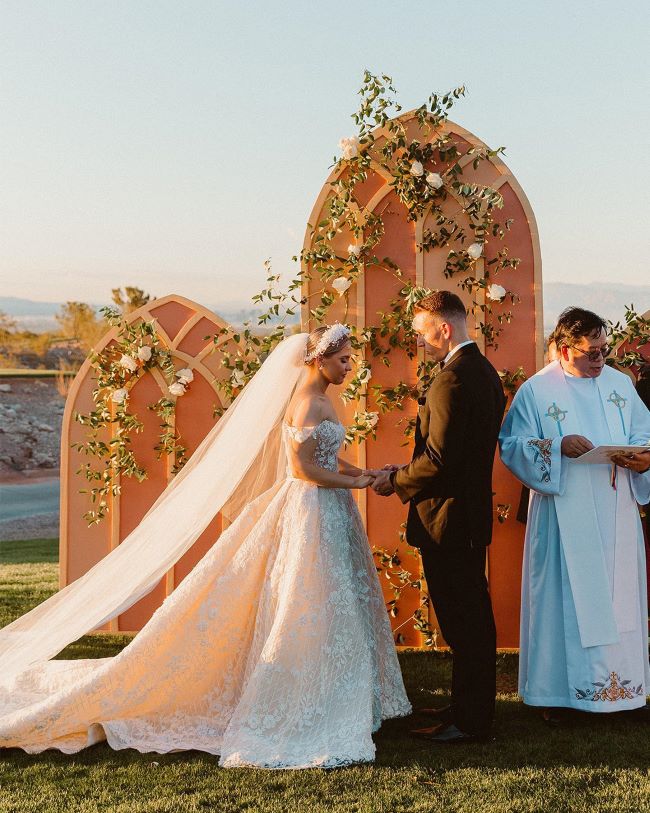
Photo by Howie Photography
Traditional Catholic Wedding Vows
Example Vows:
“I, ________, take you, ________, for my lawful wife/husband, to have and to hold from this day forward, for better, for worse, for richer, for poorer, in sickness and health, until death do us part.”
Ring Exchange Wording
After the vows are made and the couple have each declared their consent to be married, the priest presiding over the ceremony will say a blessing over the wedding rings. Once the blessing is complete, the couple will exchange rings using the following wording:
“________, receive this ring as a sign of my love and fidelity. In the name of the Father, and of the Son, and of the Holy Spirit.”
Other Traditions
Catholic weddings are full of tradition and historical practices. The act of getting married is known as the Sacrament of Matrimony, one of the seven holy sacraments of the faith. To make it a true, traditional Catholic wedding, the marriage ceremony should take place in a Church and follow a certain formula of Bible readings and prayers. There are also traditions that involve the bride being walked down the aisle by her father, rings being exchanged, and even select days of the year when the Church will not host a wedding, such as Good Friday.
Traditional Jewish Wedding Vows
Example Vows:
In Jewish ceremonies, the vows are only recited when the rings are exchanged.
Ring Exchange Wording
Traditionally, Jewish men do not wear wedding rings. If you plan to follow this tradition, the ring exchange goes as follows, and is recited in Hebrew:
Groom to the bride: “Harey at mekuddeshet li B'taba'at zo k'dat Moshe V'israel.” (Which means, “Behold, thou are consecrated unto me with this ring according to the law of Moses and of Israel.”) The groom will then place the ring on the bride’s finger.
If the groom plans to wear a wedding ring, the bride will recite the same sentence to the groom before placing the ring on his finger.
Other Traditions
Most Jewish weddings will have a four-post wedding canopy, called a Chuppah, that the couple will be married under. This canopy represents the home that these two are now creating for one another. Typically, the bride circles the groom under the Chuppah a symbolic number of times. The ceremony concludes when the groom enthusiastically breaks a glass with his right foot. The guests in attendance can then shout “mazel tov!" which translates to “congratulations.”
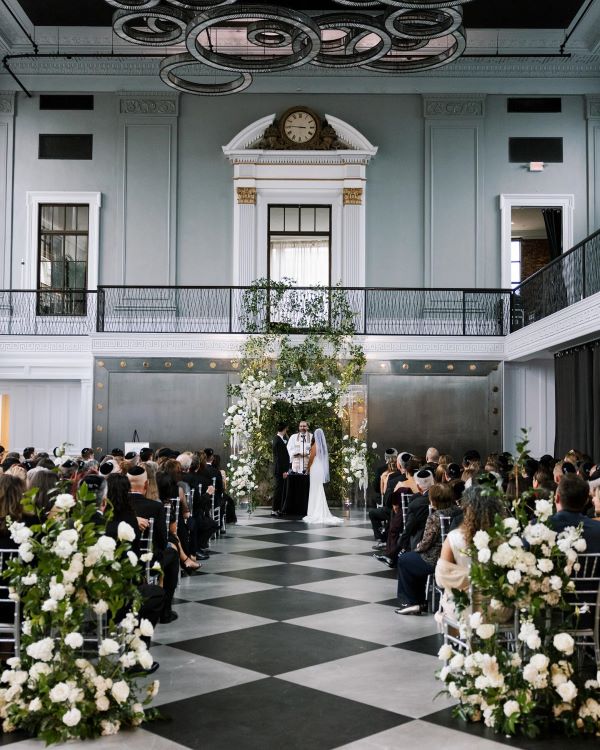
Photo by Afrik Armando
Traditional Muslim Wedding Vows
Example Vows:
Bride’s vows: “I, ________, offer you myself in marriage in accordance with the instructions of the Holy Quran and the Holy Prophet, peace and blessing be upon him. I pledge, honestly and with sincerity, to be your obedient and faithful wife.
Groom’s vows: “I, ________, pledge, in honesty and sincerity, to be your faithful and helpful husband.”
Ring Exchange Wording
In Muslim tradition, only women wear wedding rings. The following ring exchange wording flows from that tradition and is said before the groom places the ring on the bride’s finger. But, if both the bride and groom exchange rings, the bride can repeat this same wording as she places the ring on the groom’s finger as well.
Officiant, to groom: “________, you are about to enter into a sacred covenant with ________ and Allah, with these loved ones and myself as witnesses. Will you give her this ring as a symbol of your promise to honor and provide for her the rest of her life, and as a symbol of her freedom as your wife?”
Groom: “I do.”
Other Traditions
Known as the Nikah, Muslim wedding ceremonies are steeped in tradition and meaning. In addition to saying the vows above, during the ceremony, the couple will convey their willingness to marry by being asked three times if they accept each other as husband and wife and agree to the terms of the marriage contract. Each time, they respond by saying “I accept” in Arabic. It is also traditional for the groom to give the bride something significant, which is called the Mahr. This can be thought of as a dowry of jewelry, money, or property given to the wife. While a Muslim reception will be full of dancing and excitement, do keep in mind that alcohol will not be served.
Traditional Buddhist Wedding Vows
Example Vows:
Unlike in many other religions, Buddhist wedding vows do not need to be recited out loud. The couple may choose to read them silently or speak them aloud. Buddhist wedding ceremonies also include individual vows, in which each member of the couple responds with “I do,” and joint vows, in which the couple responds together with “we do.” Below, we’ve included examples of both types of vows.
Individual Vows:
“I, ________, take you, ________, to be my husband/wife, my partner in life, and my one true love. I will cherish our friendship and love you today, tomorrow, and forever. I will trust you and honor you, I will laugh with you and cry with you. Through the best and the worst, through the difficult and the easy. Whatever may come I will always be there. As I have given you my hand to hold so I give you my life to keep.”
Joint Vows:
Officiant: “Recognizing that the external conditions in life will not always be smooth and that internally your own minds and emotions will sometimes get stuck in negativity. Do you pledge to see all these circumstances as a challenge to help you grow, to open your hearts, to accept yourselves, and each other; and to generate compassion for others who are suffering? Do you pledge to avoid becoming narrow, closed, or opinionated, and to help each other to see various sides of situations?”
Wedded couple: “We do.”
Officiant: “Understanding that just as we are a mystery to ourselves, each other person is also a mystery to us. Do you pledge to seek to understand yourselves, each other, and all living beings, to examine your own minds continually and to regard all the mysteries of life with curiosity and joy?”
Wedded couple: “We do.”
Officiant: “Do you pledge to preserve and enrich your affection for each other, and to share it with all beings? To take the loving feelings you have for one another and your vision of each other's potential and inner beauty as an example and rather than spiraling inwards and becoming self-absorbed, to radiate this love outwards to all beings?”
Wedded couple: “We do.”
Ring Exchange Wording
Officiant, to bride/groom: “________, place your ring on ________’s finger and repeat after me: ‘This wedding ring is the outward and visible sign of an inward and spiritual bond which unites our two loyal hearts in partnership.”
After the bride/groom repeats the vow, they will place the ring on their spouse’s finger and say “With this ring, I promise my love and commitment.”
Other Traditions
Buddhist weddings are known for elaborate colors and attire. While brides are traditionally dressed in white in other religions and cultures, it is not uncommon in a Buddhist ceremony to see the bride dressed in layers of bright colors and fabric adorned in gold jewelry. The groom is often dressed in a brocade garment made of beautiful silks and threads.
If the ceremony takes place near a Buddhist temple, oftentimes there will be candles lit, incense burned, and offerings to Buddha presented at an altar. In addition to the individual and joint vows and the ring exchange, Buddhist wedding ceremonies may also include guided meditations and readings from passages by the Dalai Lama or Dōgen of the Soto Zen school.
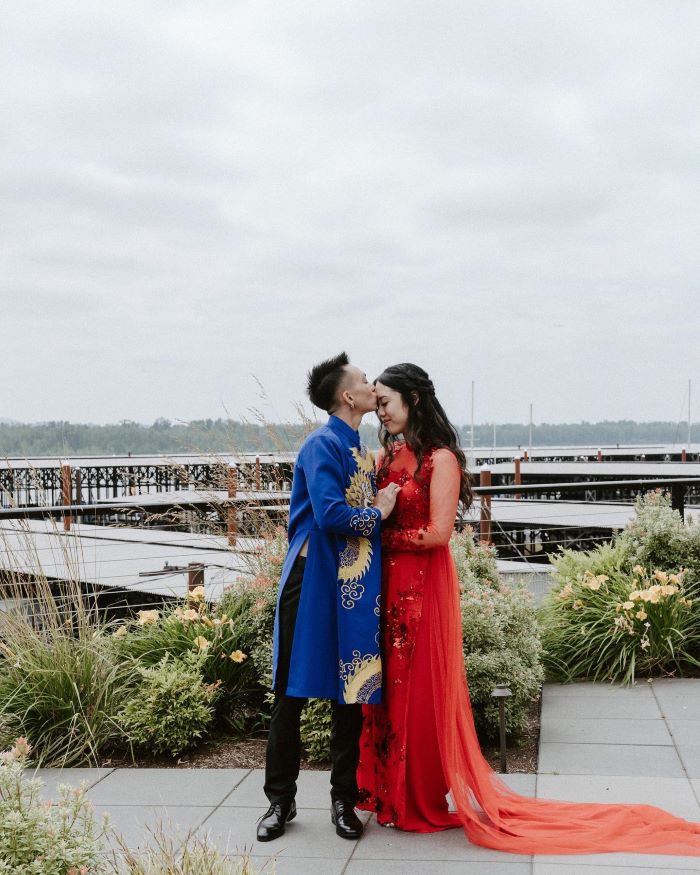
Photo by Analy Photo
Traditional Hindu Wedding Vows
Example Vows:
Traditional Hindu wedding vows are known as the saptapadi (meaning seven vows) and are chanted by the couple as they take seven mangal pheras (meaning steps) around a sacred fire. Here is what they typically include (note that vows will traditionally be said in Hindi and may be translated to English by an MC for the benefit of those who do not speak Hindi):
Vow 1: “Let us take the first step to provide for our household a nourishing and pure diet, avoiding those foods injurious to healthy living.”
Vow 2: “Let us take the second step to develop physical, mental, and spiritual powers.”
Vow 3: “Let us take the third step to increase our wealth by righteous means and proper use.”
Vow 4: “Let us take the fourth step to acquire knowledge, happiness, and harmony by mutual love and trust.”
Vow 5: “Let us take the fifth step so that we are blessed with strong, virtuous, and heroic children.”
Vow 6: “Let us take the sixth step for self-restraint and longevity.”
Vow 7: “Finally, let us take the seventh step and be true companions and remain lifelong partners by this wedlock.”
Ring Exchange
As in many Eastern cultures, a ring exchange is not a traditional part of a Hindu wedding ceremony. If the bride and groom would like to exchange rings, they will usually do so after the traditional Hindu ceremony is complete.
Other Traditions
Hindu wedding traditions can vary slightly depending on the region where the bride and groom are from, but in general, they are vibrant, multi-day affairs full of dancing, food, and symbolism. Hindu wedding celebrations will typically begin a few days before the wedding ceremony with a Mehndi ceremony in which the bride and her closest female family and friends have henna applied to their hands and feet in intricate patterns. The Sangeet ceremony, which usually is hosted the night before the wedding, brings the bride and groom’s families together to perform dances and wedding songs celebrating the couple.

Photo by Amrit Photography
Traditional Celtic Wedding Vows
Example Vows:
“You are the blood of my blood, bone of my bone. I give you my body, that we might be one. I give you my spirit, until our life is done.”
Ring Exchange Wording
There is no traditional wording that goes along with the Celtic ring exchange. Couples can choose to recite a variety of phrases — and the one we’ve included here follows Celtic poetic traditions nicely:
“I take you my heart
At the rising of the moon
And the setting of the stars.
To love and to honor
Through all that may come.
Through all our lives together
In all our lives,
May we be reborn
That we may meet and know
And love again,
And remember.”
Other Traditions
There are a few Celtic wedding traditions that are often incorporated into wedding ceremonies of various faiths and cultures across the globe. One of the most iconic is the presence of bagpipers, who will play pipes as the bride walks down the aisle. Many couples have also chosen to adopt the Celtic tradition of handfasting, which involves tying a knot in a ribbon around the bride’s and groom’s embraced hands to represent their commitment to each other.
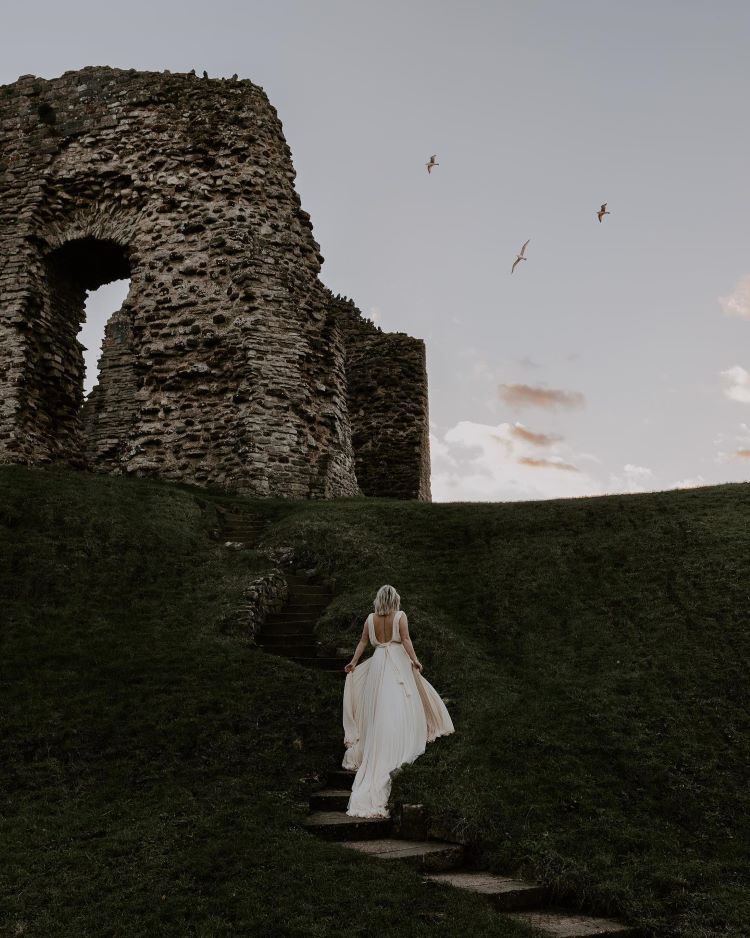
Photo by Joshua Spencer
Traditional Nondenominational Wedding Vows
Example Vows:
“I ________, take thee ________, to be my husband/wife.
To have and to hold,
in sickness and in health,
for richer or for poorer,
and I promise my love to you forevermore.”
Ring Exchange Wording
“With this ring, I thee wed, and pledge to you my love, now and forever”
Other Traditions
Non-denominational weddings occur when the couple wants to break away from the structured confines of traditional religious ceremonies, so these weddings can take on many different forms. Typically, the officiant will work with the couple to understand what traditions are important to them and create a ceremony that is a reflection of their beliefs and values. For example, the bride could opt to wear a dress that isn’t white, there could be religious references from multiple beliefs, and the wedding guests could be asked to hold candles as the couple exchanges their vows.
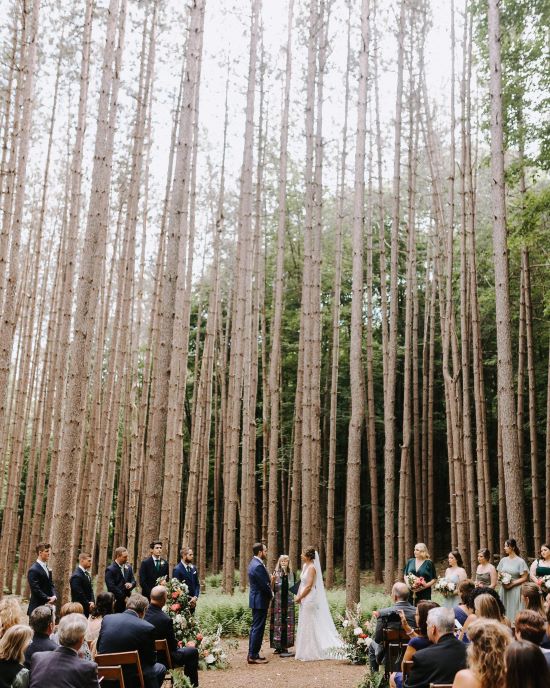
Photo by Hyde Photography
Traditional Interfaith Wedding Vows
Example Vows:
“I, ________, take you, ________, into my hand, heart, and spirit in the name of the spirit of God that resides within us all, and the love that resides inside my heart.”
“Our love has brought us back to the worlds we knew as children. I have a great amount of respect and admiration for your beliefs, even though I am not a part of them. We've promised to spend the rest of our lives together as adults, and I promise to respect your views as you do mine.”
The Ring Exchange
“With these rings, we unite our hearts in tenderness and devotion.
We will honor each other's cultures as we join customs to form a trusting relationship.
We will protect, support, and encourage each other through life’s joys and sorrows as we create a loving future.
We promise to establish a home for ourselves and our children shaped by our respective heritages; a loving environment dedicated to peace, hope, and respect for all people.
From this day forward our lives will be intertwined forever, blessed in faith, filled with compassion, understanding, and love.”
Other Traditions
At its core, marriage is the merging of two lives into one — and each interfaith couple can choose how they’d like to blend their religious traditions and beliefs into a marriage ceremony. There are many ways you can plan an interfaith wedding: You may choose to pair a Mehendi or Sangeet ceremony on the days leading up to the wedding with a Christian ceremony or combine the traditional vows spoken during a Buddhist wedding ceremony with a Jewish ring exchange. The main goal is to create a celebration that precisely reflects what makes your relationship so special in the first place.
The Perfect Way to Say I Do
No matter what faith you practice, reciting traditional wedding vows to your partner in front of your closest family and friends is a powerful way to begin your marriage. We hope these examples gave you plenty of inspiration for your own wedding ceremony, and made you even more excited to say “I do!”




